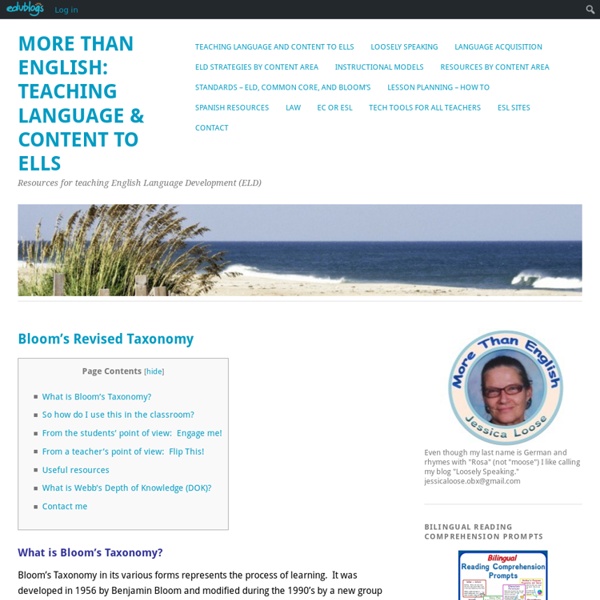Google-Proof Questioning: A New Use for Bloom's Taxonomy
The internet has revolutionized information collection. The answer to virtually any question or problem is at our fingertips. Google has made this possible. While I am a great admirer of Google and an avid user of its products, in a way, Google has made my life as a teacher a LOT more difficult. Let me explain. 1. Now I am a teacher. There are two solutions to this problem: 1. Through extensive research and investigation I have come to the conclusion that option number one will prove to be an ineffective strategy. So, what is a "Google-proof question?" Bloom's is arranged into six different levels of questioning ranging from knowledge (the simplest) to evaluation (the most complex). 1. These questions can not be Googled. We are in an age of information. Google has made my job as a teacher a lot harder, but I'm glad.
Bloomin' Apps
This page gathers all of the Bloomin' Apps projects in one place.Each image has clickable hotspots and includes suggestions for iPad, Android, Google and online tools and applications to support each of the levels of Bloom's Revised Taxonomy.I have created a page to allow you to share your favorite online tool, iOS, or Android app with others. Cogs of the Cognitive Processes I began to think about the triangular shape of Bloom's Taxonomy and realized I thought of it a bit differently.Since the cognitive processes are meant to be used when necessary, and any learner goes in and out of the each level as they acquire new content and turn it into knowledge, I created a different type of image that showcased my thoughts about Bloom's more meaningfully.Here is my visual which showcases the interlocking nature of the cognitive processes or, simply, the "Cogs of the Cognitive Processes". IPAD APPS TO SUPPORT BLOOM'S REVISED TAXONOMYassembled by Kathy Schrock Bloom's and SAMR: My thoughts
Bloom's Digital Taxonomy | Digital Learning World
As educators we are all familiar with Bloom’s Taxonomy, created in the 1950′s by Benjamin Bloom, and the more recently revised 2001 version adapted by Lorin Anderson. The original use of nouns was replaced by verbs and top level categories were re-arranged. Each category has a number of sub-categories containing key verbs associated with it: Remembering - recognising, listing, describing, identifying, retrieving, naming, locating, findingUnderstanding - interpreting, summarising, inferring, paraphrasing, classifying, comparing, explaining, exemplifyingApplying – implementing, carrying out, using, executingAnalysing – comparing, organising, deconstructing, attributing, outlining, finding, structuring, integratingEvaluating - checking, hypothesising, critiquing, experimenting, judging, testing, detecting, monitoringCreating – designing, constructing, planning, producing, inventing, devising, making (Note that the new ‘digital’ verbs introduced are coloured in blue)



